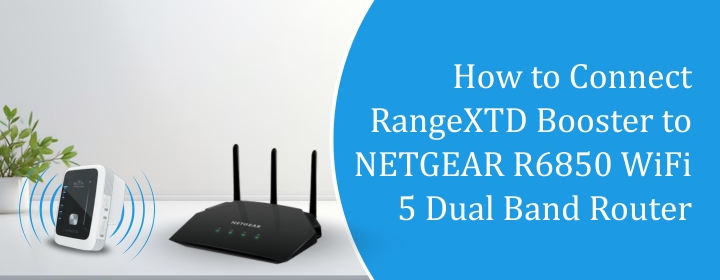
How to Connect RangeXTD Booster to NETGEAR R6850 WiFi 5 Dual Band Router
NETGEAR R6850 is quite known for its seamless internet connection. But, like many households these days, one router is not able to cover every area of the home. As a result you might face, weak signal upstairs. That’s where a booster like the RangeXTD WiFi Booster comes in.
People believe that it is hard to set up. No, it’s not. All you have to make sure is, it is done correctly. If you simply plug it in anyplace and hope for the best, it doesn’t work that way.
Therefore, we are with a guide to help you with easy setup of the device. In case of setup issues, it contains troubleshooting recommendations.
1. Ensure the Following
Reset your booster if you’re using an already existing device.
Do that by: holding the RangeXTD’s rear reset pin for 10 seconds. Let LEDs flash.
This ensures sure you don’t have to deal with previous Wi-Fi settings that might screw up the pairing later. People don’t do this, and then they wonder why the light continues flashing.
2. Look for a good place to plug it in
Placement is more important than most people assume. Don’t place your booster in a bad Wi-Fi area of your house.
Find where your NETGEAR router has a good signal. A strong signal is needed for the first connection, although you may move it afterward.
Wait for those small LED lights to stop blinking when you perform rangextd login.
3. Link your device to the booster
Get your phone or laptop now. Open the Wi-Fi settings. You will notice something like “RangeXTD” in the list of networks. Tap it.
At this moment, you don’t need a password. This is only the network configuration.
If you connect your device, it may launch a browser window on its own. If it doesn’t, simply open one yourself and enter in the rangextd login or the IP address, which is normally listed on the back of the device.
There, you’ll install the booster. Simple, but don’t rush. The setup fails 50% of the time because someone clicked “Next” too hastily.
4. Log in and let the wizard work.
The default rangextd login is usually “admin” or similar. Just enter—you may change it later. A quick setup wizard greets you inside. It will look for Wi-Fi networks that are close by. The list will reveal your NETGEAR R6850. Choose it. Be cautious when you type in your primary Wi-Fi password. At this point, the booster just grabs onto the signal from your router.
5. Rename or match the network
You may use the same SSID as your main router or generate one.
Use the same identity and password to roam freely. It will be like a gigantic blanket of Wi-Fi covering the entire home. But if you want to know precisely when your device changes networks, give the booster a name that is a little different, like “MyWiFi_EXT” or something short.
Both of them function.
6. Test the Rangextd Login quickly
After the setup is done, unplug from the temporary network that the booster put up. Then rejoin to your primary Wi-Fi network, or the one you provided a new name to.
You’ll now see complete bars if you accomplished everything properly. Not the fastest fiber-level speed, but reliable enough to stream, talk, or work without getting mad at the screen.
7. Placement Matters
Moving the booster one wall closer to the router may sometimes make a major impact.
It should be placed in such a sweet spot where the signal from the router is strong enough and the distance is vast enough to cover more ground. It’s a little bit of trial and error. We do this all the time when we install things, so don’t expect everything to be flawless the first time.
Firmware is important
Most of the time, boosters don’t receive much attention. But they require firmware upgrades just as routers do. Look on the admin page to see if there is an update pending. Install it if there is one.
Old firmware might make your Rangextd login drop at odd times, have a short range, or stop working altogether. This one little action may help you avoid random problems in the future.
8. Restart Everything Once
This phase doesn’t get enough credit. Simply restart both the booster and the router after connecting them. Take the booster out of the wall, count to ten, and then plug it back in. Do the same thing with your router.
After setting it up, it offers them a clean handshake. Most IT people do this by default. Doesn’t feel like anything… but it prevents strange minor connectivity problems from happening later.
Troubleshooting
- The booster doesn’t show up in the list of Wi-Fi networks? Set it back to its original state.
- The setup page won’t open? Type the IP right in.
- Keeps losing connection? Put it closer to the router.
- Do devices continuously switch between signals? Use the same SSID.
Don’t think too much about them. Most problems are really tiny things that don’t matter. Usually, a little change will cure it.
Final Words
Setting up a booster like the RangeXTD isn’t that hard. But it’s one of those situations where missing a minor step might ruin the entire affair.
But once it’s up and going, it makes a huge impact. No more dead spots. You don’t have to travel halfway down the hall to get a signal anymore. Just good, steady Wi-Fi all across the home. And to be honest, that’s the entire purpose.